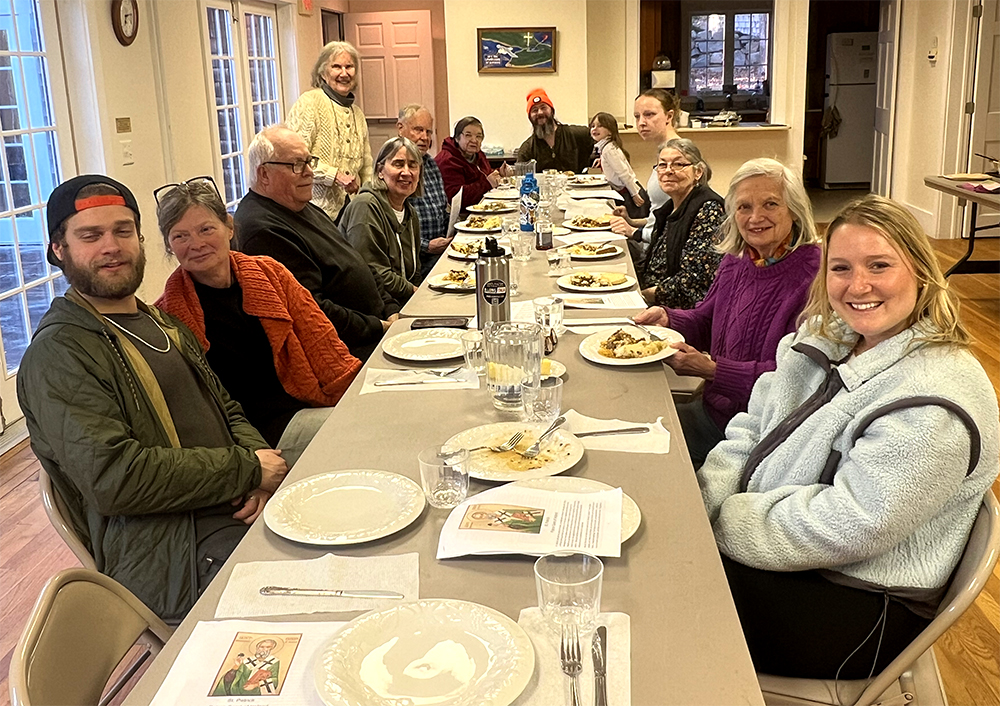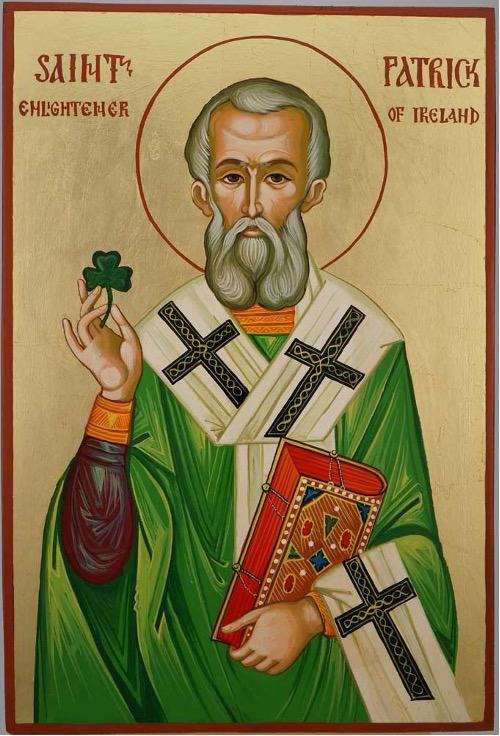Tuesday night, both community and church members gathered to learn about the life of St. Francis, the patron saint of Ireland, and to break bread together. The evening started with singing, the lesson, and prayers, and finished with delicious and nutritious Irish themed food.

Many thanks to Sean for the lively music and for baking a shepherd’s pie, and to Claire Ganz for supplying a vegetarian shepherd’s pie, to Sarah Carr for the amazing soda bread, to Pam Goff for cooked cabbage and brownies, and to Charlotte and Don Wright for veggie and rice soup and shortbread cookies.
The selection of songs sung were: “Come Though Font of Blessings”, “Oh be Thou my Vision”, and “The Water is Wide.”


St. Patrick
Patron Saint of Ireland
St. Patrick, the patron saint of Ireland, is celebrated on March 17th each year. Born in Britain during the late 4th century, his life took a dramatic turn when he was kidnapped by Irish raiders and brought to Ireland as a slave at the age of 16. Despite, or perhaps because of, the trials of his six years of captivity, Patrick drew closer to God, who appeared to him in a dream and showed him the path to escape slavery. This path led him to Auxerre where he studied and was eventually ordained to the priesthood by St. Germanus.
Around this time, he had a vision. Here are St. Patrick’s words: “I saw a man coming, as it were from Ireland…he carried many letters, and he gave me one of them. I read the heading: ‘The Voice of the Irish’…in that moment…I heard the voice of those very people…and they cried out, as with one voice: ‘We appeal to you, holy slave boy, to come and walk among us.’” And so St. Patrick returned to Ireland as a missionary.

St. Patrick’s missionary work in Ireland was remarkable, leading to the conversion of a substantial portion of the population to Christianity. Ireland was not converted by force, but rather by the words and service of St. Patrick and those who joined him on his mission. St. Patrick did not to return to Ireland as an enemy seeking to avenge himself on his captors, but he returned just as he had left: a humble servant. The Irish King Laeguire, seeking to understand Patrick’s God and His ways, assembled a council to examine the whole body of Irish law, while Patrick brought in the doctrine and law of the Church. Finding agreement through this process of reconciliation, these men side by side established a new Irish constitution called the Senchus Mor, in which the ancient pagan laws were harmonized with the new Christian law – all this without bloodshed, but simple, charitable, reasoning together.
Peaceful conversion is often considered a rare story, but Martha’s Vineyard has a similar one. The initial evangelization of the Wampanoag was left by Thomas Mayhew to Hiacoomes, a Wampanoag man who was curious about Mayhew’s religion and was eventually baptized by him. Mayhew thought it un-Christian to impose English customs on the growing Wampanoag church, so he gifted them a Wampanoag translation of the Bible so that they might learn and live the faith in their own way without English influence. While subsequent waves of mainland evangelists attempted to impose a more fervent cultural colonialism on the tribe, nonetheless the legacy of Mayhew and Hiacoomes was consequential, as the tribe’s original spiritual language and cosmology long remained the historic basis and lens through which they understood and practiced Christianity. In this way, Mayhew had a kindred spirit in St. Patrick.
Indeed, Celtic Christianity’s uniqueness is owed to St. Patrick, who did not impose a foreign cultural interpretation of Christianity on the Irish, but rather worked with the Irish so they could seek out Christ in their own pre-existing culture, traditions, and even the land herself. One of the enduring symbols associated with St. Patrick is the shamrock, a three-leaved plant. He used the shamrock, which was already a sacred symbol to the Irish, to explain the concept of the Holy Trinity—Father, Son, and Holy Spirit—to the Irish people. This simple yet powerful symbol has become synonymous with St. Patrick’s Day and is often incorporated into the celebrations.
While Ireland is known as a historically Roman Catholic nation, at the time of Ireland’s evangelization, the Church had not yet split into the Roman West and the Byzantine East. In fact, the Christian society which Patrick helped create in Ireland — a rich Celtic knot work of chapels, schools, hospitals, and farms woven together within the monastic communities across the land — was very much based on the Coptic (Egyptian) monastic model, a tradition as scholarly as it was spiritual. As scholar Thomas Cahill tells the tale in his “How the Irish Saved Civilization”, while western civilization was being raided, sacked, and destroyed on mainland Europe, its great traditions and learning were being preserved safely for future generations in the monasteries of Ireland, a small, unassuming piece of land sheltered by the great defensive moat of the Atlantic. The great histories and mythologies of antiquity, as well as books of law and the sciences, saved by Irish monks proved instrumental in the evolution of western democracy. Indeed, there might not be a United State of America if not for the work of St. Patrick and the many faithful generations of those who served in the monastic communities which he and his friends founded.
Not only all of this, but St. Patrick was even something of an action hero! It is said that St. Patrick banished the serpents – properly understood to be dragons — from Ireland!
“St. Patrick’s Breastplate” is his famous prayer. The hymn is a powerful prayer seeking protection and strength, reflecting the spiritual fervor of its author. I arise today
Through a mighty strength, the invocation of the Trinity,
Through belief in the Threeness,
Through confession of the Oneness
of the Creator of creation.I arise today
Through the strength of Christ’s birth with His baptism,
Through the strength of His crucifixion with His burial,
Through the strength of His resurrection with His ascension,
Through the strength of His descent for the judgment of doom.
I arise today
Through the strength of the love of cherubim,
In the obedience of angels,
In the service of archangels,
In the hope of resurrection to meet with reward,
In the prayers of patriarchs,
In the predictions of prophets,
In the preaching of apostles,
In the faith of confessors,
In the innocence of holy virgins,
In the deeds of righteous men.
I arise today, through
The strength of heaven,
The light of the sun,
The radiance of the moon,
The splendor of fire,
The speed of lightning,
The swiftness of wind,
The depth of the sea,
The stability of the earth,
The firmness of rock.
I arise today, through
God’s strength to pilot me,
God’s might to uphold me,
God’s wisdom to guide me,
God’s eye to look before me,
God’s ear to hear me,
God’s word to speak for me,
God’s hand to guard me,
God’s shield to protect me,
God’s host to save me
From snares of devils,
From temptation of vices,
From everyone who shall wish me ill, afar and near.I summon today
All these powers between me and those evils,
Against every cruel and merciless power
that may oppose my body and soul,
Against incantations of false prophets,
Against black laws of pagandom,
Against false laws of heretics,
Against craft of idolatry,
Against spells of witches and smiths and wizards,
Against every knowledge that corrupts man’s body and soul;
Christ to shield me today
Against poison, against burning,
Against drowning, against wounding,
So that there may come to me an abundance of reward.
Christ with me,
Christ before me,
Christ behind me,
Christ in me,
Christ beneath me,
Christ above me,
Christ on my right,
Christ on my left,
Christ when I lie down,
Christ when I sit down,
Christ when I arise,
Christ in the heart of every man who thinks of me,
Christ in the mouth of everyone who speaks of me,
Christ in every eye that sees me,
Christ in every ear that hears me.
I arise today
Through a mighty strength, the invocation of the Trinity,
Through belief in the Threeness,
Through confession of the Oneness Of the Creator of Creation.